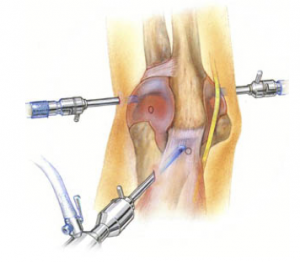An Arthroscopic elbow procedure involves inserting an arthroscope and other miniaturized surgical instruments into the elbow joint through several small (2-3 millimeter) incisions. The arthroscope includes a video camera that is used to identify the problem areas and observe the  surgery.
surgery.
These problem areas are removed using a small burr attached to the arthroscope. This procedure takes between 30 and 90 minutes with an orthopedic surgeon in Phoenix or Scottsdale, with minimal anesthesia and is done on an outpatient basis, so, normally there is no overnight stay.
Surgical procedure
Arthroscopic elbow surgery requires the use of local anesthetics and special equipment in a hospital surgery or an outpatient surgical suite. You will be given a local anesthetic and a small incision will be made to insert the arthroscope. Other small incisions will be made to use surgical instruments or to see the joint from different angles. These incisions are approximately 3-5 millimeters in diameter, similar in size and shape to a small button.
Although arthroscopy was used as a diagnostic tool for planning open surgery, with the development of more specialized surgical instruments and updated surgical procedures, many common elbow injuries can be treated with arthroscopic surgery by experienced Phoenix elbow surgeons.
To get an idea of what is involved with arthroscopic surgery; three bones come together to create your elbow. These are the humerus, radius and ulna. The humerus is the upper arm bone. The radius and ulna are your forearm bones. The radius rotates, thus allowing your arm to turn back and forth.
In addition, there is the olecranon (the bony pad on your elbow) and the epicondyles (bones on each side of the humerus) to consider. Nerves and blood vessels run alongside this collection of bones. When you add in muscles and tendons, you get an idea of the restricted space that surgeons have to work in.
 This close quarter’s surgery makes any operation on the elbow more difficult than any other type of joint surgery. Traditional open surgery used an incision to open up the elbow and work through all these parts, the miniaturized arthroscope simply moves around them to the problem.
This close quarter’s surgery makes any operation on the elbow more difficult than any other type of joint surgery. Traditional open surgery used an incision to open up the elbow and work through all these parts, the miniaturized arthroscope simply moves around them to the problem.
Since arthroscopic elbow surgery is a much less invasive surgery, recovery time can be reduced. Patients heal quicker and have less stiffness over open surgery. Instead of a long surgical scar, there will be 3-4 small puncture-like incisions made by the elbow surgeon in Phoenix or Scottsdale. All of these advantages are bringing arthroscopic elbow surgery more into the mainstream.
Recovering from surgery
After surgery, the 3 or 4 small incisions will be covered with a dressing and you will be moved to a recovery room. Since a local anesthetic is usually all that is required, you will be awake during the entire procedure. Your doctor will prescribe appropriate pain medication, but patients recovering from orthopedic elbow surgery usually need less than patients who have gone through the standard open procedure.
These patterns hold true for simple procedures, but if your problem is more complex, your surgeon will explain the other actions that may be performed if the arthroscopy discovers additional or more severe problems than were initially expected.



